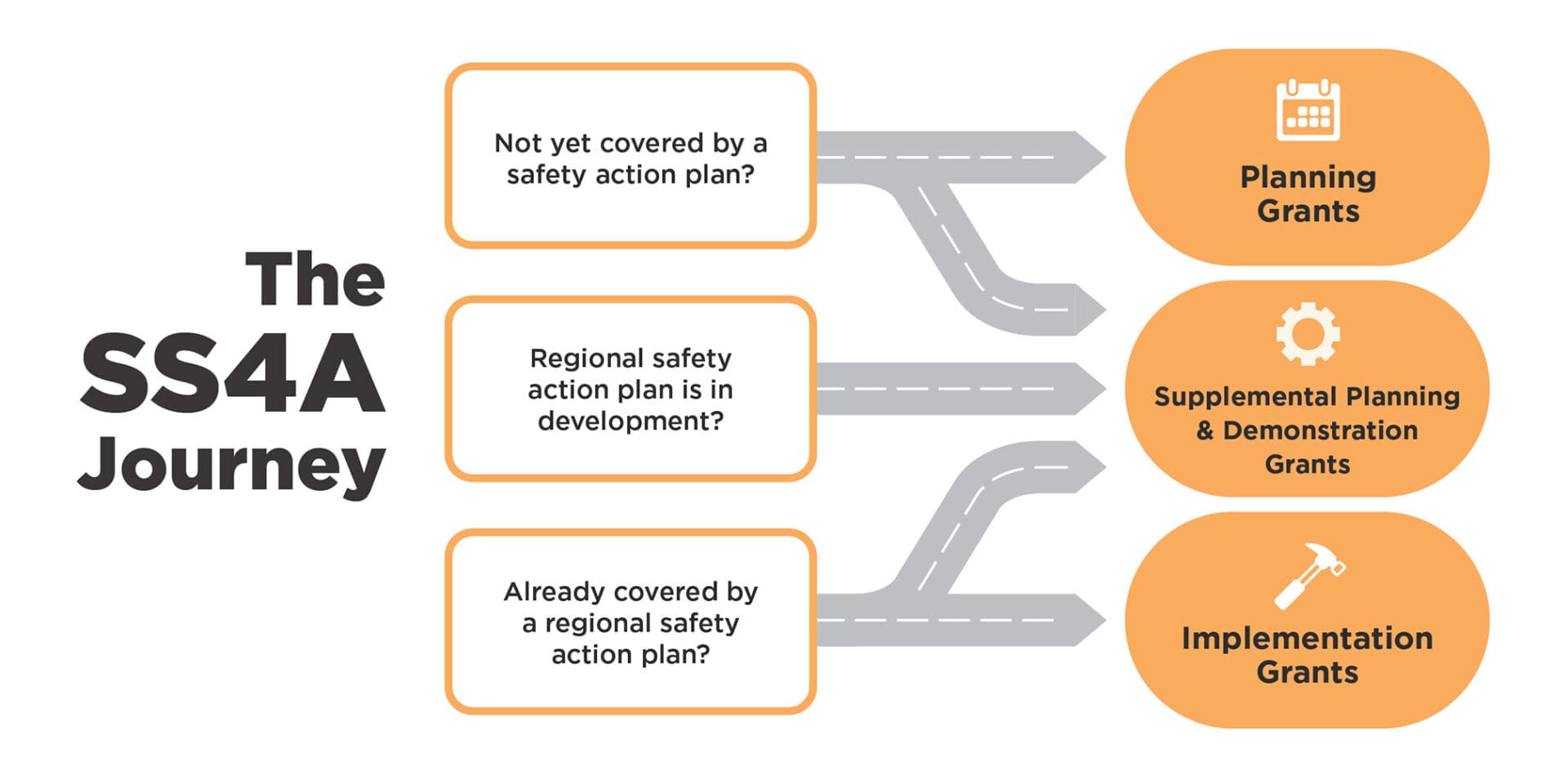March 6, 2024
Do you represent a transportation agency? Whether your agency is covered by a completed safety action plan, one is in development, or you haven’t yet taken that step, the next round of funding from the Safe Streets and Roads for All (SS4A) grant program likely has something for you!
The SS4A program is providing $5 billion in funding for projects that work to prevent deaths and serious injuries on U.S. roads, with a particular emphasis on vulnerable road users and underserved communities. On February 21, 2024, the U.S. Department of Transportation released the fiscal year (FY) 2024 Notice of Funding Opportunity (NOFO). Prior to this round, the SS4A program provided $1.7 billion in funding, meaning more than $3 billion remains to be allocated.

Whether or not you already have a safety action plan or are developing one, there are plentiful opportunities to secure funding for your community’s safety initiatives through SS4A.
The great (but sometimes overwhelming) thing about SS4A is that it can be used to fund a lot of different projects! This program is intended to support agencies through their journey across the spectrum of safety action planning and project implementation. SS4A money has helped numerous agencies initiate safety action plans and complete supplemental planning activities, while also funding projects identified in safety plans, including roundabouts, bicycle lanes, pedestrian safety treatments, road diets, widening shoulders, and other safety countermeasures.
Whether or not you already have a safety action plan (SAP) or are developing one, there are plentiful opportunities to secure funding for your community’s safety initiatives through the program’s combination of planning and demonstration grants (including supplemental planning and demonstration grants, which should be on your radar if they aren’t currently!) and implementation grants. Let’s start by mapping your agency on the SS4A journey.
Types of SS4A Grants in the February 2024 Funding Cycle
There are two broad categories of SS4A funding: planning and demonstration grants and implementation grants. A planning grant is used to develop a safety action plan, with supplemental and demonstration funding available to help with obtaining additional data and refining or enhancing strategies. Implementation grants fund specific projects identified in an SAP or other existing plan that satisfies SS4A’s criteria. These grants require strong applications that connect the project to an identified need, and will likely increase in competitiveness as more agencies finalize SAPs from earlier rounds of the SS4A program.
Where Is Your Agency on the SS4A Journey?
Because safety action plans are the needed first step to go for implementation funding, your agency likely falls into one of three categories.

Not yet covered by a local or regional safety action plan (SAP)?
Consider applying for a planning grant! SS4A provides the opportunity and means for your community to take a big step forward in prioritizing safety. A safety action plan gives you a compelling reason to engage your community in a conversation around safety, and can pave the way for prioritizing projects and obtaining future funding as you understand the issues and trends in your area and where the biggest needs are.
Note: It’s possible an existing plan already qualifies you for an implementation or supplemental planning and demonstration grant because it meets the components to be considered an eligible Action Plan for SS4A. You can check if you have an eligible plan by reviewing this worksheet. Additionally, some cities, like Springfield, Massachusetts, have fast-tracked the development of a SAP to position themselves for implementation funding as quickly as possible. Read Springfield’s story here.
Is a SAP in development?
You don’t need to have a finalized SAP to apply for additional funding through supplementary planning grants in the next SS4A cycle. Supplementary planning grants can fund studies, data collection, and other efforts to refine your plan and position you for implementation grants down the line. For example, the City of Pittsfield, Massachusetts received supplemental planning money to do a citywide traffic calming toolkit (a need that arose from a bicycle and pedestrian plan they had previously completed) and traffic calming demonstration project alongside their development of a SAP. Read Pittsfield’s story here.
Already covered by a SAP?
Supplemental planning, demonstration, and implementation grants are all viable options for you in this cycle! Even if you’re not ready for an implementation grant, there are many opportunities with supplementary planning grants. If the regional plan has done the data for you, you can focus on specific, pre-implementation action. For example, the City of Everett, also in Massachusetts, obtained supplemental planning and demonstration funding which they will use to make interim improvements as they position themselves to go after an implementation grant. Read Everett’s story here.
What Makes An SS4A Grant Application Stand Out?
Now that we’re two years into the SS4A program, we are better able to identify common elements of winning grant applications. Here are some lessons we’ve learned from our work supporting agencies in applying for SS4A funding.
Top Tips for Planning Grant Applications
Perhaps our biggest piece of advice when it comes to planning grants is: go for it! If your agency can meet the application requirements for a planning grant, you have a strong chance of obtaining funding. For some perspective, the most recent round of SS4A awarded 337 grants for planning and demonstration activities, and only 48 implementation grants.
Here are some things to keep in mind as you apply for planning money through SS4A:
- Ask for a budget and time frame that’s realistic for completing your safety action plan. This is not the time to nickel and dime your project. It takes time and money to thoroughly engage your community on this important topic, and the funding is there.
- Give yourself enough time to apply! It will take longer than you think.
- If you’re planning to use your safety action plan to position your agency for implementation funding down the line, strategize timing around future SS4A rounds—but again, be realistic! On average, once agencies are awarded planning grants, we see it take up to a year to get the MOU in place, an RFP out, and a consultant selected to develop the plan. Look at future SS4A timelines to get a sense for which implementation funding cycle you could be ready for.
- If you’re already working on other types of transportation plans (such as an active transportation plan, regional transportation plan, etc.) incorporate SS4A grant requirements into that plan to make your grant lift easier.

To receive a $3.5 million implementation grant, the Billings MPO presented a compelling narrative about needed safety improvements on routes that children use to get to school.
Top Tips for Implementation Grant Applications
Implementation grants are typically harder to get than planning grants, and require that you can thoughtfully connect your projects to the identified needs in your community. Here is what we’ve seen make implementation grant applications successful:
- Tell your community’s story. The more you can humanize the application, the more effective it will be. A good example is the Billings MPO, who presented a compelling narrative about needed safety improvements on routes that children use to get to school to receive a $3.5 million implementation grant.
- Connect your project to disadvantaged communities. This is a big focus of SS4A, so make the connection between the problem you’re trying to solve and how it will help people. Disadvantaged communities can be defined differently, so make sure to follow the SS4A definition and maps to ensure you accurately represent the population.
- Along those lines, the more initial outreach you can do to disadvantaged communities, the more competitive your application will be. Creative outreach, ideally done before applying, shows you’re putting thought into how you’ll reach people who are less likely to engage otherwise.
- Tie strategies into your local needs and contexts (urban vs. rural). Show how the countermeasures you’ve identified make sense for your community using data. (This is where a supplemental planning grant can be handy! Consider getting one to do before/after studies that will advance your implementation grant.)
- Speak in measurable terms. How will you measure success?
- Finally, make sure you’re prepared to implement! While obtaining grant money is always exciting, if you’re a smaller agency, have a plan for how you will create capacity on your team or outsource work so that you can implement these new projects.
We’re Here to Help!
At Kittelson, we’ve had the pleasure of helping agencies obtain SS4A funding packages ranging from $200,000 to $15 million. If you’re looking for support pulling together a grant application, we invite you to check out examples on our website of how we’ve helped clients assess what grants they’re positioned for, navigate grant requirements, and tell their story in a compelling and human way. Deadlines for the FY 2024 NOFO are April 4, May 16, and August 29 for planning and demonstration grants, and May 16 for implementation grants. We welcome the opportunity to open a conversation about how this could work for your community; we’re eager to get agencies of all sizes connected to funding opportunities and taking advantage of what SS4A is offering!
